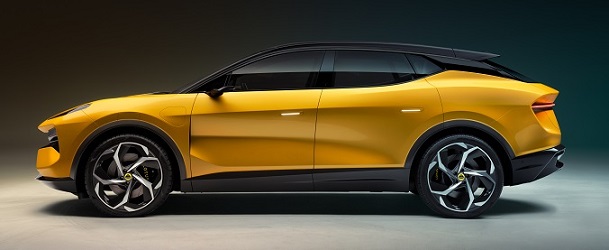Key specs
Lotus Eletre (SUV) Eletre 2023,2024,2025,2026
What is the body type, Lotus Eletre 450 kW 2023?
SUV, 5 Doors, 5 Seats
How fast is the car, Lotus Eletre 450 kW 2023?
258 km/h - 160 mph
How long is this vehicle, Lotus Eletre 450 kW 2023?
5103 mm
How wide is the vehicle, Lotus Eletre 450 kW 2023?
2231 mm
What is the curb weight, Lotus Eletre 450 kW 2023?
2490 kg
Lotus Eletre (SUV) Eletre 2023,2024,2025,2026 Specs
General information
| Brand |
Lotus |
| Model |
Eletre (SUV) |
| Version |
Eletre |
| Engine version |
450 kW |
| Year production start |
2023 |
| Vehicle type |
SUV |
| Horsepower RPM |
603 hp |
| Acceleration 0 - 100 kmh sec |
4.5 |
| Curb weight kg -lbs total |
2490 kg
|
| Overall length mm - inch |
5103 mm
|
| Doors |
5 |
| Top Speed |
258 km/h - 160 mph |
Engine specs
| Powertrain architecture |
Electric full-time AWD with Lotus ICC intelligent torque distribution |
| Electric motor power |
450 kW
|
| Electric motor torque |
710 Nm
|
| Engine location |
front and rear wheels
|
| Eng 56 |
Battery capacity 112 kWh
|
| Eng 57 |
Battery Lithium-ion
|
| Eng 59 |
20 mins for 80% charge with 350 kW DC
|
Transmission and Drive system
| Transmission |
single speed |
Brakes
| Front brakes |
412 mm ventilated discs |
| Rear brakes |
397 mm ventilated discs |
| Parking brake |
electric park brake |
Suspension
| Front suspension |
Multi-link |
| Rear suspension |
Multi-link |
| Suspension-97 |
Dual chamber air springs |
Wheels & Tyres
| Wheels rims |
20''- 22''-23'' |
Passenger
| Passengers seats |
5 |
| Trunk space min liter | cu. Ft. |
611 liters
|
| Trunk space max liter | cu. Ft. |
1532 liters |
Dimensions
| Overall length mm - inch |
5103 mm
|
| Overall width mm -inch |
2231 mm
|
| Overall height mm -inch |
1630 mm
(20'' wheels)
|
| Wheelbase mm - inch |
3019 mm
|
| Track width front mm - inch |
1706 mm
|
| Track width rear mm - inch |
1684 mm
|
| Coefficient of drag |
0.26
|
| Dimensions-168 |
ground clearance 187 mm (20'' wheels) |
Weights
| Curb weight kg -lbs total |
2490 kg
|
Fuel economy
| Autonomy km (combined use) |
600 km / 373 miles |
Engine type
Electric
https://www.thecarspec.com/components/engine/electric

